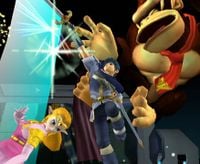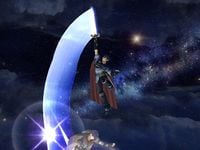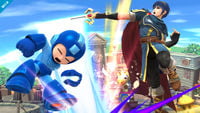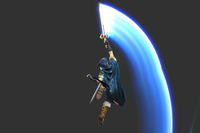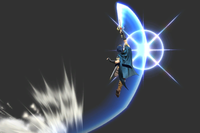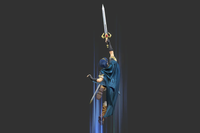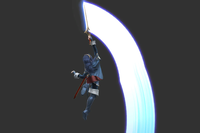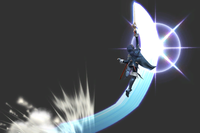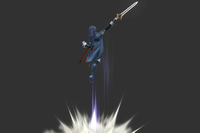Dolphin Slash
| Dolphin Slash | |
|---|---|
{{{content1}}}
{{{content2}}} Dolphin Slash in Super Smash Bros. Ultimate. | |
| User | Marth Lucina |
| Universe | Fire Emblem |
The Dolphin Slash (ドルフィンスラッシュ, Dolphin Slash) is Marth and Lucina's up special move.
Overview
Marth or Lucina slightly move forward, quickly swipe their sword upwards and perform a high-spiraling leap, with their blade extended horizontally-to-vertically. The player can angle the move to either gain more horizontal distance or more vertical distance and the player can also reverse the move, similar to Super Jump Punch. Right before they start rising, the move has a fast (frame 5) and fairly powerful hitbox which either launches opponents horizontally or vertically depending on how close the opponent is to the user. As the user is rising, the move has a much weaker hitbox which lasts for a short period of time. Once the user has finished their ascent, they will slowly stall in the air until they start falling, where they have very limited aerial mobility. It provides decent vertical recovery, but very little horizontal recovery which overall makes it an exploitable recovery move, especially in earlier games. The move is quite effective as an attack however due to its fast speed, respectable range, decent strength and the fact that it provides some intangibility during its startup, which gives it a fair amount of utility in other areas. As well as being a recovery move, it can be used as an out of shield option (being Marth/Lucina's fastest OoS option), an escape tool, an edgeguarding tool or as a combo ender.
In Super Smash Bros. Melee
In Super Smash Bros. Melee, Dolphin Slash comes out on frame 5 and Marth is intangible during this one frame. At the tip of the sword, the move deals 13% and strong horizontal knockback (especially at lower percents) while at a closer range, the move only deals 10% and much weaker vertical knockback. The tipper does have the highest priority out of all the move's hitboxes though, which does make it easier to land than most of Marth's other tipper attacks. The sweetspot KOes Mario at around 80% at the edge of Final Destination and at around 130%-140% from the center. After the move's first active frame, the move's hitboxes become drastically weaker, dealing 7% or 6% depending on where the move lands allowing with drastically weaker horizontal or vertical knockback. These hitboxes last until frame 12 and Marth can grab ledges starting from 23 of the animation.
Because of these factors, the move is best used as an attack when the opponent is in directly front of Marth. The move is a very effective attack due to its fast speed, long range and strong power which notably makes it effective as either an out of shield option or as a combo ender. The clean hit also cannot be directly challenged due to Marth being intangible, although the opponent can hit Marth before or after the hitbox comes out. The move is Marth's fastest Out of Shield option, being one frame faster than his grab (it is a frame 6 OoS option as Marth has to be in jumpsquat for one frame before he can use it). When combined with its strength, this can make it Marth's most desirable OoS option in some situations.
The main drawback the move as an attack however it that it is extremely punishable. After jumping up, Marth stalls in the air for some time before he starts falling and when he starts falling, he has incredibly limited horizontal control. When used near the edge, Marth cannot drift to the edge to reduce the total lag and if he is facing the ledge and fails to reverse it, he will lose a stock. The move has a heafty 34 frames of landing lag which when combined with the previous points, gives the opponent a lot of time to punish Marth. This can often lead into a stock, even at very low percents as opponents can either charge a very powerful punish or begin a devastating combo. Marth can utilise platforms to make the move harder to punish, especially since he can quickly land on the top platform on tri-plat stages and the move can be edge-canceled although both options are not always available, the former option is still very punishable while the latter is very difficult to perform.
As a recovery move, Dolphin Slash is rather subpar overall. While the move's hitboxes do make it risky to challenge and it does cover decent vertical distance, the move does not travel far horizontally at all and the move can very easily be edge hogged, due to its short duration. An edge roll consistenly beats Dolphin Slash and Marth often cannot do anything to avoid it. The opponent can even use an angled light shield at the ledge to get hit by Dolphin Slash which will then make them slide off to grab the ledge. Marth's only real option is to land on stage but that puts him in a punishable amount of landing lag and he often cannot edge cancel the move in a recovery situation either.
Reverse Dolphin Slash
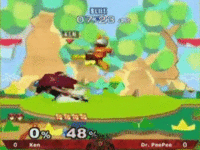
A "Reverse Dolphin Slash" can be performed by starting the attack and quickly moving the joystick backwards. This will cause Marth to turn around just before jumping upwards, with it occurring right after the move's clean hit. While this is naturally useful for recovering, Marth can also use it to hit opponents in front of him with the sweetspot and then turn around. This makes Dolphin Slash an effective edgeguarding tool as Marth can hit a recovering opponent with the sweetspot (which has high horizontal knockback) and then he can turn around to make it back to the stage. Marth can also use a reverse Dolphin Slash as a combo ender, being an alternative finish to a Ken Combo in situations where his down aerial is either impossible to land or too risky. This is particularly useful in the PAL version of the game, where down aerial's sweetspot was changed from a spike to a meteor smash.
While a reverse Dolphin Slash is effective at dealing with opponents in front of Marth, it is not particularly strong at dealing with opponents behind Marth. As the turnaround happens on frame 6, the move's hitboxes are much weaker once Marth turns around. Opponents have to be very close to Marth in order for him to hit them if they are directly behind him and it Marth does hit them, the move is highly punishable on hit right up until higher percents.
Overall, Dolphin Slash is a subpar recovery move but a high risk high reward attack with utility in numerous areas.
In Super Smash Bros. Brawl
In Brawl, the regular Dolphin Slash appears to be at least as powerful as Melee's Reverse Dolphin Slash. Marth can be seen jump-cancelling a shield into it for potential kills at about 100% (130% on heavyweight characters).
This move in Brawl has several more advantages than the version in Melee. It has more horizontal range, can be angled more noticeably forward, and its vertical recovery is still great. It is also one of the few moves to retain the speed it had in Melee. However, it lacks the higher potential to KO in comparison.
What makes this move really useful are the invincibility frames starting on frame 1 to 5, allowing Marth to escape chain grabs and multi hit attacks. However, when used for this purpose, Marth is left helpless and vulnerable to attack. The move hits the opponent on frame 5, like it did in Melee.
In Super Smash Bros. 4
Dolphin Slash returns in Super Smash Bros. 4 as Marth's up special move, and his clone Lucina also possesses the move as well. Its sweetspot is very slightly smaller, making it a bit harder to hit a reverse Dolphin Slash. However, all other hitboxes of the move are slightly larger. It has significantly less landing lag than in previous games, making it safer if the user is forced to land helpless. However, the grounded version now only has two frames of intangibility (frames 4–5), making it more unsafe as an out-of-shield move against lingering hitboxes. Before update 1.0.8, it dealt drastically reduced knockback, making it useless for KOing until extremely high percentages where it would not be viable.
However, starting from the 1.0.8 update, Dolphin Slash's knockback has been significantly buffed. It now has KO potential at percentages around 130% (significantly lower with rage), and due to its speed it can easily catch opponents off guard, along with giving the user a hard-hitting option to escape pressure if platforms are available. The landing lag was also reduced further in the same update. As such, it is considered a much more viable move than in previous patches, and arguably gives back the strength it had originally lost from Brawl.
Although hitting a reverse Dolphin Slash is now very rare, the move is still very useful for edgeguarding and stage spiking due to its speed, especially against poor and slow recoveries such as Dark Dive and Duck Hunt Jump. Dolphin Slash is now arguably a better recovery move with the removal of edge-hogging, as the move still has great vertical reach and speed. It still has limited horizontal movement, but can still be angled slightly.
In Super Smash Bros. Ultimate
Dolphin Slash remains the same in Ultimate but has slightly more landing lag.
Instructional quotes
| Strike upward as you rise through the air. | ||
| Strikes upward as he rises into the air. Deals the most damage at the start. | ||
| Strikes upward as she rises into the air. Deals the most damage at the start. |
Customization
Special Move customization was added in Super Smash Bros. 4. These are the variations:
| 1. Dolphin Slash | 2. Crescent Slash | 3. Dolphin Jump |
|---|---|---|
| "Strike upward with your sword as you rise into the air. Deals most damage at the start." | "Rise in an arc while attacking. Deals most damage at the midpoint. Doesn't go as high." | "Jump really high, but you won't deal any damage." |
| 1. Dolphin Slash | 2. Crescent Slash | 3. Dolphin Jump |
|---|---|---|
| "Strike upward with your sword as you rise into the air. Deals most damage at the start." | "Rise in an arc while attacking. Deals most damage at the midpoint. Doesn't go as high." | "Jump really high, but you won't deal any damage." |
- Dolphin Slash: Default.
- Crescent Slash: Attacks at a steeper angle but with less height. Does most damage at the midway point.
- Dolphin Jump: Jumps higher but deals no damage.
Origin
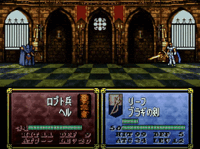
Although the move has not been named or seen in any of the Fire Emblem games, Dolphin Slash's animation loosely resembles the jumping portion of the critical hit animations of the swordmaster class from Fire Emblem Thracia 776. This follows the trend of Fire Emblem's unique animations being given a name and ability in Super Smash Bros., such as Shield Breaker being based on Marth's standard attack animation.
The name could be a reference to the GameCube itself, as it was codenamed the Dolphin. It may also reference Marth's royalty, as the French word dauphin—which directly translates to "dolphin"—is defined as "the eldest son of the King of France."[1] Marth is a firstborn prince, and therefore the term dauphin could be applied to him.
Gallery
Dolphin Slash in Super Smash Bros. for Wii U.
Names in other languages
Trivia
- The sound effect of the Dolphin Slash varies from Melee to Brawl. In its first appearance, Marth grunts while the sword makes a very slight woosh sound. However, in Brawl, Marth is silent, and the sword now makes a very loud slash, almost akin to an explosion. In Smash 4, Dolphin slash does a more typical slashing sound, louder than Melee but softer than Brawl.
- In SSB4 since version 1.0.8, and in Ultimate, Lucina occasionally grunts when using Dolphin Slash. Marth, however, does not.
- In Fire Emblem Warriors, Marth's Strong Attack includes a rising jump slash very similar to Dolphin Slash, though it is not named as such.
